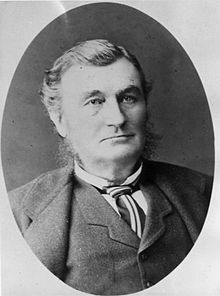William Robinson (runholder)
|
The Hon William Robinson MLC |
|
|---|---|

Portrait of William Robinson
|
|
| Member of the New Zealand Legislative Council | |
|
In office 4 May 1869 – 9 September 1889 |
|
| Personal details | |
| Born |
4 May 1814 Warrington, Lancashire, England |
| Died | 9 September 1889 (aged 75) Christchurch, New Zealand |
| Resting place | Riccarton Cemetery, Christchurch |
| Political party | Independent |
| Spouse(s) | Eliza Jane Robinson (nee Wood) |
| Relations | Francis Bell (son-in-law) |
| Occupation | runholder |
William Robinson (4 May 1814 – 9 September 1889), also known as Ready Money Robinson, was a New Zealand and member of the New Zealand Legislative Council.
Robinson was born in 1814 in Bold Hall near Warrington, Lancashire, England. His parents, Thomas Robinson and Elizabeth Lyons, were tenant farmers.
He emigrated to South Australia in September 1839 on the Lady Lilford, and promptly took up grazing pursuits, being a pioneer settler at Inman Valley. His next venture, in 1841, was droving 6,000 sheep and 500 cattle overland from New South Wales to South Australia. In 1844, on the Hill River in the Clare Valley he established the prosperous Hill River Station, comprising over 100 square miles (260 km2). He there became a close associate of fellow pastoralist John Jackson Oakden who, like Robinson, was later to move to New Zealand.
He married Eliza Jane Wood on 4 July 1846 at Adelaide. They had five daughters; their son died as an infant. His third daughter, Caroline, was to marry Francis Bell, a later Prime Minister, in 1878.
He came to New Zealand in 1856 as a wealthy man and was known as Ready Money Robinson for his ability to make large purchases in cash. He resided in Nelson, and bought Cheviot Hills estate. William James Gardner, in his book A Pastoral Kingdom Divided, said that this "was probably the largest and most spectacular transaction of the kind ever undertaken in New Zealand". The land, which extended from the Hurunui River in the south, the Waiau River in the north, the Lowry Peaks range to the west and the Pacific Ocean coastline to the east, amounted to 84,243 acres (34,092 ha). Only the Glenmark station of George Henry Moore was more valuable.
...
Wikipedia
